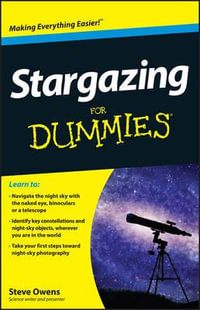
At a Glance
384 Pages
24 x 18.5 x 2
Paperback
RRP $41.95
$35.95
14%OFF
or 4 interest-free payments of $8.99 with
orAims to ship in 7 to 10 business days
More and more frequent extreme weather events occur each year, and wildlife everywhere is increasingly endangered. Science fiction or science fact, most climate experts see this as our world on climate change—and, according to polls, a majority of people around the globe agree. Climate Change For Dummies allows you to investigate this hottest of hotly debated issues for yourself—examining its causes, the way it affects our lives, and what we can all do to make a difference.
This straightforward guide—cowritten by the former leader of Canada's Green Party and the Canadian Chief of Staff to the Minister of Natural Resources—sifts the fact from the fiction: Is climate change caused by human activity or by natural elements beyond our control? What contribution can clean energy make? What are our best and worst-case scenarios?
- What are the likely long- and short-term effects?
- How can human activity can impact the environment?
- Can individuals and governments help reverse the possible effects?
- Which are the best sources of cleaner energy?
About the Authors
Elizabeth May is the former leader of the Green Party of Canada. She founded and served as the Executive Director of the Sierra Club Canada from 1989 to 2006. May has been the Member of Parliament in Canada since May 2011.
John Kidder was a founding member of the Green Party in British Columbia. He has been a cowboy, miner, fisher, range management specialist, technology entrepreneur, small farmer, and governance practitioner since then.
The authors married on Earth Day 2019.
Introduction 1
About This Book 1
Foolish Assumptions 2
Icons Used in This Book 3
Beyond This Book 3
Where to Go from Here 4
Part 1: Understanding Climate Change 5
Chapter 1: Covering the Basics of Climate Change 7
Getting a Basic Overview — Global Warming 101 8
Heating things up with GHGs 8
Investigating other causes of global warming 9
Tapping into The Roots of Global Warming 12
Fueling global warming 12
Heating up over deforestation 13
Examining the Effects of Global Warming around the World 13
The United States and Canada 14
Latin America 16
Europe 17
Africa 18
Asia 18
Australia and New Zealand 19
Small islands 20
Polar regions 20
Positive Politics: Governments and Global Warming 22
Making a difference from city hall to the nation’s capital 22
Working with a global government 23
Helping developing countries 23
Solving the Problem 24
Changing to alternative energies 24
Getting down to business 25
Making it personal 26
Chapter 2: Looking Closely at Greenhouse Earth 27
Examining Greenhouse Effect 101 28
Focusing On Carbon Dioxide: Leader of the Pack 30
Looking at the carbon cycle 31
Investigating humanity’s impact on the carbon cycle 36
Checking Out the Other GHGs 39
Methane (CH4) 40
Nitrous oxide (N2O) 42
Hexafluoro-what? 42
Other players on the GHG bench 43
Chapter 3: Recognizing the Big Deal about Carbon 47
Considering Other Causes of Global Warming 48
Solar cycles — Irradiance and Milankovitch 49
Cloud cover 49
Long-term climate trends 50
Making the Case for Carbon 51
Geologic and prehistoric evidence 52
Modeling and forecasting 53
A few degrees is a lot 55
Going, going, gone The tipping point 56
Eyeballing the Consequences of Continued Carbon Dioxide Increases 57
What happens when the mercury rises 58
Cutting back on carbon 58
Part 2: Tracking Down the Causes 61
Chapter 4: Living in the Dark Ages of Fossil Fuels 63
From Fossils to Fuel — How Fossil Fuels Came to Be 64
Examining the Different Types of Fossil Fuels 66
Coal 67
Oil 68
Natural gas 71
Fueling Civilization’s Growth: Adding to the Greenhouse Effect 73
A growing world population’s impact 73
Growing economies also play a role 74
Chapter 5: Getting Right to the Source: The Big Emitters 77
Power to the People: Energy Use 77
Producing electricity 78
Using up energy in buildings 79
Powering industry 81
The Road to Ruin: Transportation and GHGs 84
Cheap goods at a high price to the climate 85
Keep on truckin’ 85
Draining the Carbon Sinks: Land Use 87
Timber! Deforestation 87
Down on the farm: Agriculture and livestock 88
Chapter 6: Taking It Personally: Individual Sources of Emissions 91
Driving Up Emissions: Transportation and GHGs 92
Driving 93
Flying 94
Using Energy around the House 95
Controlling the climate in your home 96
Operating electric appliances 98
You Are What You Eat: Food and Carbon 99
Wasting Away 99
Part 3: Examining the Effects of Climate Change 101
Chapter 7: Focusing on Not-So-Natural Disasters 103
H2 Oh No: Watery Disasters 104
Rising sea levels 104
Melting mountain glaciers 106
Putting a brake on the Gulf Stream 109
Rainfall (or lack thereof) 111
Flooding 111
Freshwater contamination 113
Stormy Weather: More Intense Storms and Hurricanes 113
Forest Fires and Wildfires: Trees and Grasses as Fuel 114
Considering the costs 115
Recognizing how they start and how to prevent them 115
Turning Up the Heat 116
Examining the Negative Side Effects of Positive Feedback Loops 117
Chapter 8: Risking Flora and Fauna: Impacts on Plants and Animals 121
Understanding the Stresses on Ecosystems 122
Ecosystems can adapt to some climate change 122
Some species have limitations for adapting 123
Warming the World’s Waters: Threats to the Underwater World 124
Under the sea 125
Lakes, rivers, wetlands, and bogs 129
Risking Earth’s Forests 130
Tropical 131
Boreal 131
Preparing for Mass Extinctions 133
Life’s no beach: Endangered tropical species 134
Thin ice: Polar bears and other polar animals 135
Chapter 9: Hitting Home: Global Warming’s Direct Effect on People 137
Focusing on the Health Scare — Outbreaks and Diseases 138
Dengue fever 139
Lyme disease 140
Other diseases and problems worsened by global warming 140
Putting Pressure on the Fields 143
Affecting farmers 143
Hurting the global food supply 144
Paying the Price for Global Warming 145
Highways, waterworks, and the other stuff humans build 146
An unfair split: Costs to the industrialized and developing nations 147
Feeling the Heat First: Unequal Effects 149
Northern Hemisphere communities 150
People in poverty 152
Women (and children) 152
Part 4: Political Progress: Fighting Global Warming Nationally and Internationally 155
Chapter 10: Voting for Your Future: What Governments Can Do 157
If They Had a Million Dollars (Wait — They Do! —Funding Measures 159
Creating incentives 160
Planning for emissions trading 161
Putting Programs into Place 164
Research 164
Education and awareness 165
Adaptation 166
Cleaning Up Transportation 171
Bringing back the bike 171
Investing in public transportation 172
Greening cars 172
Dealing with personal vehicles 173
Redefining Long-Term Investments 174
Considering the lack of progress 175
Focusing on the good news 175
Recognizing the countries leading the way 176
Laying Down the Law 178
Improving building regulations 178
Regulating energy use 179
Taxing the polluters 180
Identifying Some Success Stories 182
Cities and towns 182
States, provinces, and territories 183
Countries 185
Chapter 11: Beyond Borders: Progress on a Global Level 187
Understanding Why Global Agreements Are Important 188
Examining the U.N. Framework Convention on Climate Change 189
Recognizing what the Convention does 190
Establishing a game plan 191
Dividing up the parties 192
Looking At the Paris Agreement 193
Setting targets 193
Adding flexibility 196
Ratifying climate pacts 197
Introducing the World’s Authority on Global Warming: The IPCC 198
Getting to know the IPCC 199
Reading the reports 199
Chapter 12: Developing in the Face of Climate Change 201
Identifying Challenges Faced by Developed and Developing Nations 202
Promising Developments: Looking at Progress in China, Brazil, and India 204
China 205
Brazil 208
India 211
Choosing Sustainable Development 213
Understanding what sustainable development is 213
Expressing what developing countries can do 214
How industrialized countries can help 216
Part 5: Solving the Problem 221
Chapter 13: Powering the World — Renewable Green Energy 223
Addressing Energy Demand 224
Being more efficient 224
Combining heat and power 226
Changing How to Handle Fossil Fuel’s Emissions 227
Capturing and storing carbon dioxide 228
Considering carbon capture cons 230
Reducing Energy Demand 231
Investigating Renewable Energy Options 232
Blowin’ in the wind 233
Here comes the sun 235
Heat from the ground up 238
Hydropower 239
Ocean power 240
From plants to energy 241
Nothing wasted 242
Exploring Another Nonrenewable Energy Source: Nuclear Power 245
Understanding nuclear power 245
Looking at the positives 246
Weighing the negatives 246
Chapter 14: Show Me the Money: Business and Industrial Solutions 249
Processing and Manufacturing Efficiently 250
Taking steps to conserve energy 251
Using energy efficiently 252
Considering individual industries 253
Trading Carbon between Manufacturers — The Carbon Market 254
Constructing Greener Buildings 256
Cutting back on heating and cooling 256
Exploring energy alternatives 257
Certifying new buildings 257
Identifying Corporate Success Stories 258
Recognizing Corporate Nonsuccess Stories 259
Focusing on Support from the Professional Service Sector 261
Banking on the environment 261
Stranding assets and liabilities 262
Insuring against climate change 263
Making it legal 264
Looking At Farming and Forestry 264
Supplying biofuels 265
Improving land management 265
Reducing rice farms’ emissions 268
Chapter 15: Activists without Borders: Nongovernmental Organizations 271
Understanding What NGOs Do 272
Educating people 272
Keeping watch 273
Getting the word out 274
Working with industry and government 275
Meeting This Generation 278
The importance of youth 279
Groups that speak up 279
Getting Involved 280
Seeking out groups 280
Helping out 281
Chapter 16: Lights, Camera, Action: The Media and Climate Change 285
Growing News Coverage 285
Bias and balance: Distorting the story 286
Consider the source: Being an informed media consumer 286
Focusing on Science on the Red Carpet 288
Movies: Facts and (science) fiction 288
For the kids (and adults, too) 291
Following the stars 292
Worldwide Warming: Climate Change Blogs 293
Bestselling Books: Reading between the Lines 294
True stories 294
Fiction and fairytales 296
Chapter 17: Figuring Out How to Change before Global Warming Is Unstoppable 297
Asking Tough Questions 297
Making the Changes in Limited Time 298
Staying within the carbon budget: Is it possible? 299
Getting to net zero — Is it possible? 300
Staying below “1.5 to stay alive” — Is it possible? 300
Addressing What Needs to be Done 301
Forecasting a path to 1.5 degrees 301
Understanding Disruption 303
Predicting what disruption of fossil fuels looks like 303
Recognizing the cost of disruption 304
Considering other benefits to disruption 306
Ending the Dominance of Fossil Fuels as Humanity’s Main Source of Energy 308
Changing the ways humans use energy and power to get things done 308
Changing what political leaders see the best interests of humanity 309
Understanding How Disruption Can Be Accelerated 311
Getting There from Here: A Conversation among Citizens 312
Part 6: The Part of Tens 315
Chapter 18: Ten (Plus One) Things You Can Do to Fight Climate Change 317
Greening Your Car 318
Upgrading Major Appliances 319
Buttoning Up Your House 319
Making Your Daily Living More Energy Efficient 319
At home 320
On the road 320
At work 321
Going Vegetarian or Vegan (Sort of) 322
Reducing Food Waste 322
Supporting Clean, Renewable Energy 323
Being a Smart Investor and Encouraging Smart Disinvestment 324
Getting (or Making) a Green Collar Job 324
Helping To Make Change Where You Live 326
Spreading the Word 327
Chapter 19: Ten (Plus Three) Inspiring Leaders in the Fight 329
Arnold Schwarzenegger 330
Angela Merkel 330
Mia Amor Mottley 331
Bill McKibben 331
George Monbiot 331
Sheila Watt-Cloutier 332
Elizabeth Wathuti 332
Greta Thunberg 333
Michael Mann 333
Katharine Hayhoe 334
James Hansen 334
Bill Gates 335
Nandita Bakhshi 335
Chapter 20: Top Ten Myths about Climate Change Debunked 337
Knowing That a Debate Doesn’t Exist among Scientists 338
Recognizing That Human Activity Has Caused Current Global Warming 339
Looking into the Danger of Increased Carbon Dioxide Concentrations 340
Discovering the Truth about Sunspots 340
Understanding That Scientists Don’t Exaggerate to Get More Funding 341
Grasping the Misconceptions about the Science of Global Warming 341
Thinking It’s All Your Fault 342
Considering You Can’t Do Anything about It 343
Pinning the Blame on Developing Countries Isn’t Realistic 343
Living with Climate Change — and Doing Something about It 344
Chapter 21: Ten (Plus One) Online Climate Change Resources 345
National Geographic 346
Three Other Kid-Friendly Sites 346
Intergovernmental Panel on Climate Change 347
Climate Analysis Indicators Tool 347
Canada’s Environment and Climate Change 347
The U.K.’s Climate Challenge 348
Environmental Protection Agency 348
The International Energy Agency 349
Gateway to the UN System’s Work on Climate Change 350
Index 351
ISBN: 9781119703105
ISBN-10: 1119703107
Series: For Dummies
Published: 8th April 2022
Format: Paperback
Language: English
Number of Pages: 384
Audience: General Adult
Publisher: John Wiley & Sons Inc (US)
Country of Publication: US
Edition Number: 1
Dimensions (cm): 24 x 18.5 x 2
Weight (kg): 0.7
Shipping
| Standard Shipping | Express Shipping | |
|---|---|---|
| Metro postcodes: | $9.99 | $14.95 |
| Regional postcodes: | $9.99 | $14.95 |
| Rural postcodes: | $9.99 | $14.95 |
How to return your order
At Booktopia, we offer hassle-free returns in accordance with our returns policy. If you wish to return an item, please get in touch with Booktopia Customer Care.
Additional postage charges may be applicable.
Defective items
If there is a problem with any of the items received for your order then the Booktopia Customer Care team is ready to assist you.
For more info please visit our Help Centre.























